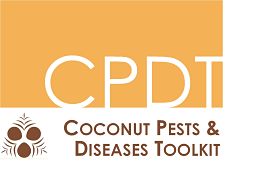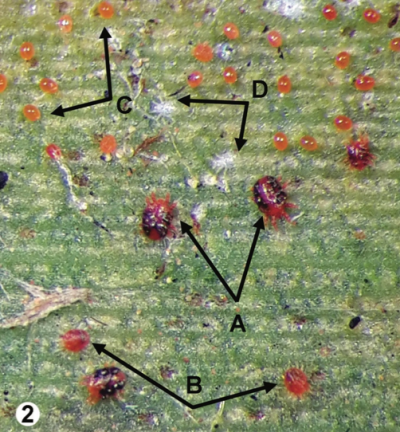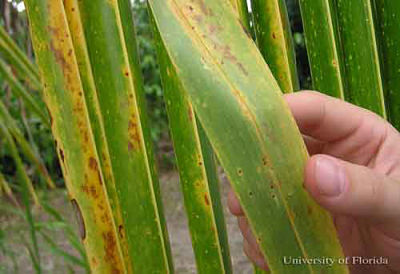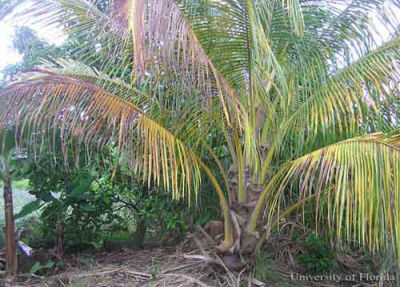Red palm mite
The red palm mite is a serious pest of coconut and other important crops. This is a HIGH risk pest.
Common nameRed palm mite |
Scientific nameRaoiella indica (Acari: Prostigmata: Tenuipalpidae) |
on this page: Life-cycle and identification : Symptoms : Impacts : Distribution : Prevention : Controlling red palm mite : Information sources and further reading
Life-cycle and identification
The red palm mite goes through five life stages. These stages are egg, larva, two nymphal stages (protonymph, deutonymph) and adult. The nymphal stages are very similar to the adults and even the larval stage is also difficult to differentiate from nymphal stages without a microscope.
The mites are generally found on the undersides of leaves. Colonies look like reddish-brown areas on the leaves.
Eggs : Larvae : Nymphs : Adults
Eggs
Eggs are laid on the lower part of the leaves, either laid singularly or in colonies of 110 - 330 individuals. Each adult female contributes approximately between 28 - 38 eggs to these colonies.
The reddish eggs are small (around 0.12 mm long by 0.09 mm wide) and smooth. They are red in colour but will turn an opaque white 24 hours before hatching.
Hatching usually occurs 6-9 days (longer for fertilized than for unfertilized eggs) after being laid.
The length of each life stage can vary with temperature. Lower temperature, usually below 20°C, will increase the length of each life stage.
There may be 30-100 million mites per palm!
LarvaeLarvae hatch from the eggs. The larvae are small bright orange to red in colour. They are about 0.20 mm long with three pairs of legs. Much like the adult female, they may have a small black spot on their back after feeding. Larvae feed on palm leaves for about 3-5 days, then stop around 1-2 days before growing (moulting) into the protonymphal stage. NymphsNymphs are the young mite and look similar to adults, only smaller. There is a protonymphal and deutonymphal stage. The protonymph emerges from the larval stage with four pairs of legs. The protonymph feeds on the palm leaves for 2-5 days then enters a stage of rest for 1-4 days. After this non-feeding rest stage the deutonymph emerges as a larger nymph. They also feed for 2-5 days then enter a resting stage (2-4 days) before emerging as an adult. The females deutonymph will produce a sex pheromone to attract males close to them. Because of this pheromone attraction mating can occur as soon as the nymphs mature as adults. |
Stages of the red palm mite. A) Adult female B) nymphs C) eggs and D) moulted exoskeleton from growth (© Daniel Oliveira, Embrapa Roraima) |
AdultsAdult mites are bright red in colour. Males have a triangular body and are generally smaller than the round and flat females that are around 0.3 mm long. Females can also be identified after feeding by the dark markings that appear on their back. The adults have setae (bristle-like structures) on their back. A drop of liquid may be noticeable at the end of the setae. Red palm mites have long, U-shaped mouthparts with long whiplike appendages, for piercing plant tissue when feeding. The red palm mite does not produce silk and is slow moving in comparison to spider mites (which red palm mites can be mistaken for). Females live for about 30 days, slightly longer than the more active males which live for around 26 days. Adults are sexually mature as soon as they emerge from the nymphal stages. Females that mate (i.e. eggs are fertilised) will produce all female young. If the female does not mate she will produce all male young. This is known as parthenogenesis - the egg is developed without fertilisation. |
Microscopic image of an adult red palm mite. Note the drop of liquid at the end of the setae (hairs) and long, u-shaped mouthpart for piercing plant tissue (Magnified about 300x.) (© Eric Erbe and digital colorisation Chris Pooley, USDA) |
SymptomsYellow splotches will appear on either side of the leaflets as the tissue dies from the red palm mite feeding on the deep tissue layers of leaves. Yellowing may be scattered throughout the leaflet, or the entire leaflet might be yellowed through the midrib. Heavy infestations can cause all of the leaves to be yellowed and dead. This will occur mainly on the lower third of the crown. Yellowing of the leaves can be confused with lethal yellowing. |
Yellow splotches on leaves and yellowing of the midrib (© Jorge Peña, University of Florida) |
|
Once yellowing has occurred, the development of flowers may stop or nuts will be small. Seedlings and old mature palms more than 15 metres tall can be susceptible to damage. However, young palms are most often affected. ImpactsThe data on economical impacts are sparse. However, since the mite was introduced into the Caribbean and the Americas, coconut plantations have reported drops in production of around 70%. The yellowing of palms from mite infestations has also greatly affected coconut palms used as features for tourism or landscaping in private properties. |
Lower third of a coconut palm with most of the leaflets yellowed and dead (© Jorge Peña, University of Florida) |
Regulations that have been implemented to stop the spread of the mite have created extra costs. Palm nursery producers in Florida have cited an extra $500,000 US per year in production costs.
Distribution
Please check with your local biosecurity / quarantine or SPC for up-to-date distribution information.
The red palm mite is found in Asia, Africa and the Americas (Central, North, South and the Caribbean).
See our distribution spreadsheet for the detailed distribution of the red palm mite.
Prevention
Most importantly, the International Guidelines for transfer of coconut germplasm should be strictly followed to prevent pests and diseases being moved to new locations.
The red palm mite has a wide host range, allowing it to spread easily through movement of host materials.
Palm handicrafts are an introduction pathway. These are commonly transported as souvenirs.
Use hand lens to check on the underside of leaves for infestations before plant products are transported.
To prevent further introductions and spread, palm handicrafts, host plant materials and other palm products must be quarantined. The items can be treated with bleach, dye, paint or shellack.
The mite may disperse via wind currents. This mode of spread is difficult to control. Wind dispersal can be further assisted by hurricanes and storms. The lack of natural predators also assist in its spread within new ranges.
For general information on preventing pests and diseases of coconut, see the Prevention section.
Controlling red palm mite
We strongly recommend an integrated pest management (IPM) approach to the control of all insects, where possible. This is a combination of methods (pesticides, physical controls such as site hygiene, and biological controls) to minimise the use of pesticides and minimise the cost of control.
Integrated Pest Management (IPM)
The goal of IPM is to keep pest populations to a level below which they cause economic harm. IPM involves using multiple control options together for the economic control of pests (i.e. cultural, natural and chemical).
In an agricultural context the Food and Agriculture Organization defines IPM as "the careful consideration of all available pest control techniques and subsequent integration of appropriate measures that discourage the development of pest populations and keep pesticides and other interventions to levels that are economically justified and reduce or minimize risks to human health and the environment. IPM emphasizes the growth of a healthy crop with the least possible disruption to agro-ecosystems and encourages natural pest control mechanisms".
Cultural
The affected parts of the palm should be cut and disposed of. The less contact these materials have with the environment the better. Commercial companies should follow these guidelines as well.
The United States Department of Agriculture (USDA) recommends that infested material should be restricted from distribution to unaffected areas.
Natural
Red palm mite has many natural predators that can be used for biological control.
Effective predators are Coccinellidae (ladybird beetles), Phytoseiidae (predatory mites), and Chrysopidae (lacewings).
Other predators have been reported in India such as Oligota sp. (staphylinid beetle), Phytoseius sp. and Amblyseius sp. (predatory mites). Predatory phytoseiid mites such as Amblyseius can be found in high numbers in red palm mite infestations. Amblyseius caudatus is said to feed on the red palm mite eggs and adults at a rate of up to 17 a day.
USDA, University of Florida (UF), and Florida Department of Agriculture and Consumer Services - Division of Plant Industry (FDACS-DPI) are currently working at identifying potential biological control agents of red palm mites for Florida.
Chemical
Acaricides (mite and tick poisons) are not 100% effective. These pesticides can be used to suppress high populations of mites at first but should be followed up with natural and biological controls. Due to the size and height of the palms, chemical control is impractical and costly.
Insecticidal soaps and horticultural oils can be used but have to be applied directly to the mites.
30ml of Golden Pest Spray Oil (soya bean oil) per 1 gallon of water has been successful in nurseries.
Information sources and further reading
Bugwoodwiki. 2013. Raoiella indica. [ONLINE]
CABI. 2018. Raoiella indica (red palm mite). [ONLINE]
Faleiro et al. 2016. Integrated Pest Management (IPM) of Palm Pests. Integrated Pest Management in the Tropics, pp. 453 - 458.
Global Invasive Species Database. 2018. Species profile: Raoiella indica. [ONLINE]
Hoy, Peña, Nguyen (UF). 2012. Featured creatures; Red palm mite. [ONLINE]
Hoy, Peña, Nguyen (UF). 2015. Red Palm Mite, Raoiella indica Hirst (Arachnida: Acari: Tenuipalpidae). pp. 1-5.
Molet. 2013. CPHST Pest Datasheet for Raoiella indica. USDA-APHIS-PPQ-CPHST. pp. 1-13. [ONLINE]
Oliveira et al. 2016. First Report of Raoiella indica (Acari: Tenuipalpidae) in Southeastern Brazil. Florida Entomologist, 99, 1, pp. 123-125.
Plantwise. Red palm mite (Raoiella indica). [ONLINE]
content reviewed by Qing Hai Fan, Plant Health and Environment Laboratory, Ministry of Primary Industries, New Zealand, October 2018


 _opt.jpg)

